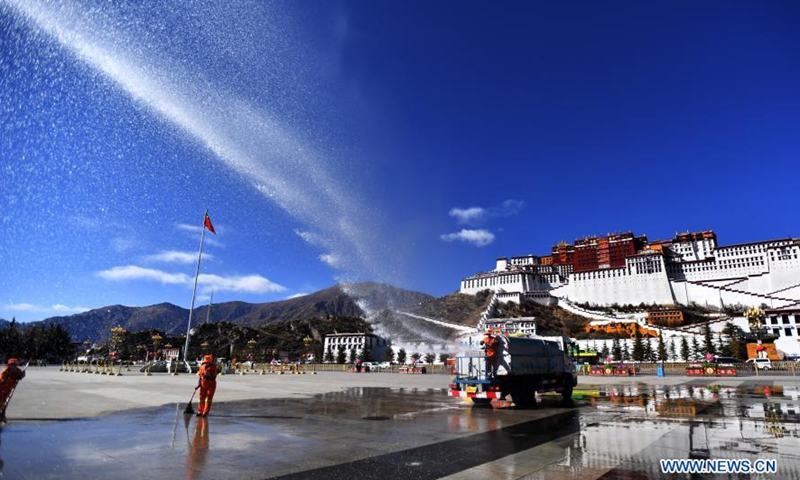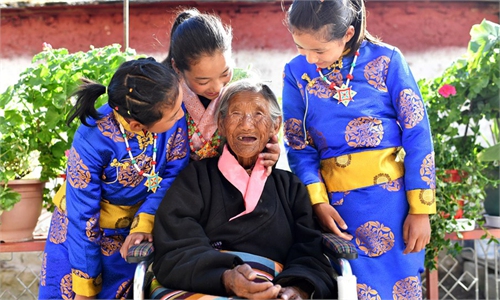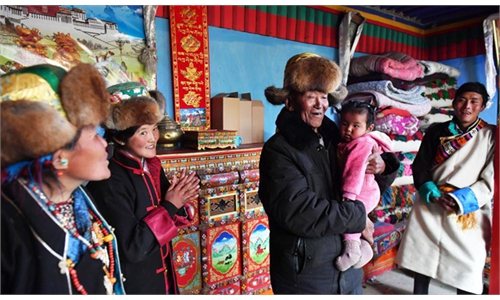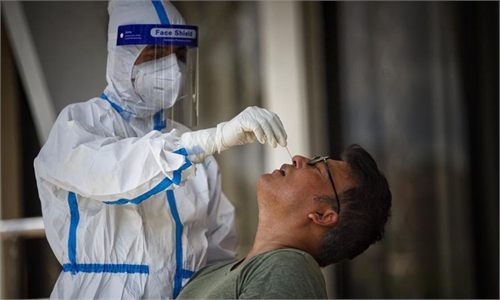
Sanitary workers clean the square of the Potala Palace in Lhasa, capital of southwest China's Tibet Autonomous Region, Feb. 8, 2021. Both the Spring Festival and the Tibetan New Year falls on Feb. 12 this year.Photo:Xinhua
Epidemic outcomes for China's ethnic minorities have not been as expected in Western mainstream discourse. A former US State Department official even claimed that China's governance system makes it incapable of combating viral outbreaks in the effective way of liberal democracies. Meanwhile, a leading UK business journal stated that diseases like COVID-19 are deadlier in non-democracies.One might expect that ethnic minorities groups would fare better during the epidemic in countries like India than in China, but the fact has been the contrary: In the US, UK, and India minorities are overrepresented among the victims. In the US, with the only exception of Asian Americans, Indigenous, Black and Pacific Islander, and Latino Americans all have a COVID-19 death rates double or more that of White Americans.
In China, ethnic minorities seem to be underrepresented among COVID-19 victims. Ethnicity-based statistics on COVID-19 are not readily available, but it is still possible to make inferences. Central China's Hubei Province has about 66 percent of China's total cases and its capital city Wuhan was the epicenter of the COVID-19 outbreak. Hubei's ethnic minorities mainly live in Enshi, which recorded only 74 COVID-19 cases per million residents, the lowest prefecture-wide case rate in the province.
In comparison, the US' largest indigenous nation, the Navajo, had 30,722 COVID-19 cases and 1,293 deaths on its reservation as of May 18, 2021. Based on the 173,000 reservation (2010 census) population, that is 177,854 cases and 7,474 deaths per million, about 1.75 times the case rate and 4 times the death rate of the US population as a whole.
The result for the Navajos comes from the 40-percent poverty rate on the reservation, inadequate funding of healthcare and infrastructure, high rates of heart disease, diabetes and obesity, and 30-40 percent of residents lacking running water, making it difficult to wash hands as often as recommended.
A comparison can also be made between the epidemic situation in Southwest China's Tibet Autonomous Region, where the population of 3.5 million is 90-percent Tibetan, and situation among Tibetan exiles in India and Nepal, with a population of about 86,000.
As of May 3, 2021, 2,584 Tibetans in India, Nepal and Bhutan had tested positive, with 59 deaths, media reported. By May 18, 2021, the situation had worsened. Among Tibetans in India, Nepal and Bhutan, there had been 3,510 cases and 88 deaths.
Chinese official data shows only one case and no deaths in the Tibet Autonomous Region, which has about one-eighth of China's territory. Harvard Medical School professor Dr. William Haseltine has affirmed the reliability of China's COVID-19 statistics.
In short, ethnic Tibetans in China have been much better protected from the virus than their co-ethnics in India. Ironically, the so-called Tibetan government-in-exile in India has called on countries to sue China in the International Court of Justice for having spread the virus. In fact, as University of Queensland virologist Ian McKay has observed, the lockdown of Wuhan effectively diminished the virus' spread to other parts of China.
The difference between how Tibetans in China and India have fared in the epidemic is not because those in India lack the means for adequate care. Tibetans in India get significant funds and other supports from Western NGOs, and from the Indian government under its Tibet Rehabilitation Policy. The US government gives $9 million annually to Tibetan exile groups, while the US Congress has also given a $23 million grant.
The more precarious epidemic situation of Tibetan exiles communities in India, compared to Tibetans in China, is the result of disastrous policies at the national level, and perhaps locally as well. The comparison belies both the insistence in Western discourse that liberal democratic political systems are necessarily superior to China's system, and the specific claim that ethnic minorities must be better off wherever there is an alternation of parties in power.
Barry Sautman is visiting professor at Hong Kong University of Science and Technology. Yan Hairong is associate professor at Hong Kong Polytechnic University. opinion@globaltimes.com.cn



